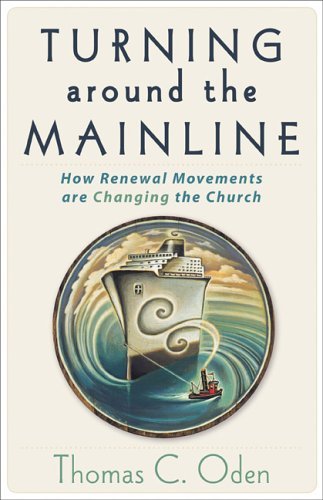Thomas C. Oden: Turning around the Mainline

Thomas C. Oden, Turning around the Mainline: How Renewal Movements are Changing the Church (Grand Rapids: Baker, 2006), 270 pages.
This latest book by Thomas C. Oden gathers together for the first time the prevailing themes and documents of the confessing and renewal movements within mainline denominations. It also includes a case study concerning the most difficult issue confronting these movements, the property rights of local churches. This book was inspired by a 2003 Christianity Today lead article called “Turning the Mainline Around” with a cover picture of a huge ship being turned around by a tiny tugboat. This image of the ship and tugboat is also on this book’s cover.
This significant change may seem ironic, but it is happening. The mainline churches, Oden argues, are indeed being “turned around” by ordinary church members who are orthodox and evangelical in their faith. These confessing/renewal movements are growing rapidly. They involve a major ecumenical realignment never seen before in American church history.
Oden has the laity in mind in writing this book. Oden also wanted his book to be useful for onlookers from the wider evangelical world, not just for the benefit of the faithful mainline church member. Within this largely uncharted territory, this book serves as an unexpected and reassuring “newsflash” for the wider evangelical world concerning what is happening to their distant relations in the faith.
Oden approaches his task here primarily as an archivist. The renewal of interest in orthodoxy and evangelical teaching has garnered great attention. This attention has not been seen in the last one hundred years. Oden believes this is the right time to offer a true account of these events. The mainline confessing/renewal movements must speak for themselves without any editorial commentary.
Oden’s message is divided into six parts (p. 15). Those parts and his explanation of those parts are, I feel, the best summary of this book. The parts are: “Coming Home in the Mainline,” “Inspecting Ground Zero,” “Trekking to the Other Side of the Stream,” “Relearning the ABCs,” “Coming to the Table,” and “Paying the Mortgage.” Oden’s journey begins with the reader being at the homeplace – mainline denominations. The reader sniffs the smoke from the debris of ground zero – the destruction. The reader then explores while journeying to the other side of the mainstream and then back to the fundamentals – confessing/renewal movements. The reader then attends the great banquet – confession at the Lord’s Table. Finally, the reader appears in court to deal with legal issues – ownership of local church property. In other words, there must be a return to the home to survey the damage. There then must be a reinvestigation of how the neighbors coped with the crisis. This ultimately leads back to the primitive classroom to relearn the values that once made the neighborhood great. This will then lead to a coming again to the great banquet that unifies the community under a common history. Once that happens, the only thing left to do is the unpleasant task of sorting out who owns the property now.
I am attracted to this book because of two main reasons. The first reason is that I see an overarching theme underlying everything discussed within this book. Oden calls it “spine.” (p. 17). Since these issues are so controversial, it takes a person with a real backbone to attempt an examination of them. I believe Oden indeed has the determination and courage to do it. The second reason is that Oden draws his illustrations, specifically the illustrations involving church property, from the United Methodist Church. Oden is a conservative, evangelical United Methodist. I am one also. I can personally identify with his illustrations because we both share the same denominational heritage, and my concerns for the direction of the United Methodist Church are similar to the concerns he expresses.
Category: Ministry, Spring 2007


